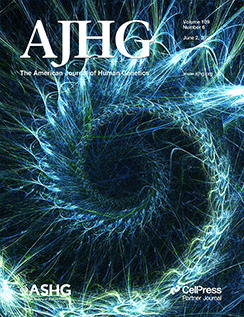由eIF3复合成分基因EIF3A和EIF3B的功能缺失变异引起的一种心血管、颅面和神经发育障碍。
IF 8.1
1区 生物学
Q1 GENETICS & HEREDITY
引用次数: 0
摘要
综合征性心脏畸形可导致发病率,但其遗传病因只了解一小部分个体。先天性异常队列的基因组测序工作可能会在以前未被识别的基因中识别出疾病相关的变异。通过国际配对的努力,我们确定了18个EIF3A (n = 4)或EIF3B (n = 14)有新生或功能丧失变异的个体。临床表型各不相同,但主要包括心脏缺陷、颅面畸形、轻度发育迟缓和行为异常。这些基因编码真核起始因子3 (eIF3)复合物的核心亚基,在翻译起始过程中将mRNA转录物结合到40S核糖体亚基中起关键作用。这两个基因在功能丧失方面都受到高度限制,动物模型表明,eIF3复合物的破坏会导致一系列发育缺陷,包括心血管畸形。此外,EIF3B位于与7p22.3微缺失相关的心脏异常相关的最小重叠区域。我们试图进一步研究这些基因在综合征型先天性心脏病中的作用。为了探索它们的功能影响,我们制作了具有同源eif3s10和eif3ba基因突变的斑马鱼模型,这些基因突变会导致发育异常,包括心管变薄、颅面软骨缺失和胚胎致死。我们认为,EIF3A的致病变异,以及涉及EIF3B的致病变异或微缺失,导致了一种独特的常染色体显性神经发育综合征,其特征是心血管和颅面表现。本文章由计算机程序翻译,如有差异,请以英文原文为准。
A cardiovascular, craniofacial, and neurodevelopmental disorder caused by loss-of-function variants in the eIF3 complex component genes EIF3A and EIF3B.
Syndromic cardiac malformations can result in morbidity, yet their genetic etiology is only understood for a subset of individuals. Genome sequencing efforts in congenital anomaly cohorts may identify disease-associated variants in previously unrecognized genes. Through international matchmaking efforts, we identified eighteen individuals in total with de novo or loss-of-function variants in EIF3A (n = 4) or EIF3B (n = 14). The clinical phenotype varied but predominantly included cardiac defects, craniofacial dysmorphisms, mild developmental delays, and behavioral abnormalities. These genes encode core subunits of the eukaryotic initiation factor 3 (eIF3) complex, which plays a critical role in binding mRNA transcripts to the 40S ribosomal subunit during translation initiation. Both genes are highly constrained against loss of function, and animal models have demonstrated that disruptions in the eIF3 complex result in a range of developmental defects, including cardiovascular malformations. Additionally, EIF3B is located within the minimally overlapping region implicated in cardiac anomalies associated with 7p22.3 microdeletions. We sought to further study the role of these genes in syndromic congenital heart disease. To explore their functional impact, we generated zebrafish models with mutations in the orthologous eif3s10 and eif3ba genes, which resulted in developmental abnormalities, including thin heart tubes, lack of craniofacial cartilage, and embryonic lethality. We propose that pathogenic variants in EIF3A, as well as pathogenic variants or microdeletions involving EIF3B, cause a distinct autosomal-dominant neurodevelopmental syndrome characterized by cardiovascular and craniofacial manifestations.
求助全文
通过发布文献求助,成功后即可免费获取论文全文。
去求助
来源期刊
CiteScore
14.70
自引率
4.10%
发文量
185
审稿时长
1 months
期刊介绍:
The American Journal of Human Genetics (AJHG) is a monthly journal published by Cell Press, chosen by The American Society of Human Genetics (ASHG) as its premier publication starting from January 2008. AJHG represents Cell Press's first society-owned journal, and both ASHG and Cell Press anticipate significant synergies between AJHG content and that of other Cell Press titles.

 求助内容:
求助内容: 应助结果提醒方式:
应助结果提醒方式:


